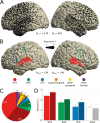Music can be reconstructed from human auditory cortex activity using nonlinear decoding models
- PMID: 37582062
- PMCID: PMC10427021
- DOI: 10.1371/journal.pbio.3002176
Music can be reconstructed from human auditory cortex activity using nonlinear decoding models
Abstract
Music is core to human experience, yet the precise neural dynamics underlying music perception remain unknown. We analyzed a unique intracranial electroencephalography (iEEG) dataset of 29 patients who listened to a Pink Floyd song and applied a stimulus reconstruction approach previously used in the speech domain. We successfully reconstructed a recognizable song from direct neural recordings and quantified the impact of different factors on decoding accuracy. Combining encoding and decoding analyses, we found a right-hemisphere dominance for music perception with a primary role of the superior temporal gyrus (STG), evidenced a new STG subregion tuned to musical rhythm, and defined an anterior-posterior STG organization exhibiting sustained and onset responses to musical elements. Our findings show the feasibility of applying predictive modeling on short datasets acquired in single patients, paving the way for adding musical elements to brain-computer interface (BCI) applications.
Copyright: © 2023 Bellier et al. This is an open access article distributed under the terms of the Creative Commons Attribution License, which permits unrestricted use, distribution, and reproduction in any medium, provided the original author and source are credited.
Conflict of interest statement
The authors have declared that no competing interests exist.
Figures








